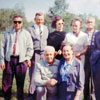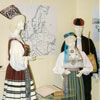Medicine Valley Estonian Society
 By 1910, there were an estimated 50 Estonian pioneers living in the Medicine Valley area. In that same year the Medicine Oru Eesti Selts (Medicine Valley Estonian Society) became the focal point for Estonian community life in central Alberta. The organization amalgamated other Estonian groups into one coherent network. For example, the local Estonian band and choir, originally founded in 1906, joined the Medicine Valley Estonian Society (MVES) in 1910, performing at various Estonian functions throughout the Medicine Valley. Within a year, the MVES established a lending library providing literature for adults and children. Communal enterprises were also incorporated into the MVES framework. These included a branch of the Co-operative Association (1912), Gilby (Kalmu) Cemetery Board (1914), and the Eckville Telephone Association, organized in 1917. The MVES utilized a multi-faceted approach in its relationship with the Estonian community of Medicine Valley. Dynamic and resourceful, the MVES reflected the Estonian commitment to teamwork, cooperation, and community-based initiatives. Moreover, by incorporating other groups into the organization, the MVES could meet its cultural, economic, and political objectives.
By 1910, there were an estimated 50 Estonian pioneers living in the Medicine Valley area. In that same year the Medicine Oru Eesti Selts (Medicine Valley Estonian Society) became the focal point for Estonian community life in central Alberta. The organization amalgamated other Estonian groups into one coherent network. For example, the local Estonian band and choir, originally founded in 1906, joined the Medicine Valley Estonian Society (MVES) in 1910, performing at various Estonian functions throughout the Medicine Valley. Within a year, the MVES established a lending library providing literature for adults and children. Communal enterprises were also incorporated into the MVES framework. These included a branch of the Co-operative Association (1912), Gilby (Kalmu) Cemetery Board (1914), and the Eckville Telephone Association, organized in 1917. The MVES utilized a multi-faceted approach in its relationship with the Estonian community of Medicine Valley. Dynamic and resourceful, the MVES reflected the Estonian commitment to teamwork, cooperation, and community-based initiatives. Moreover, by incorporating other groups into the organization, the MVES could meet its cultural, economic, and political objectives.
Medicine Valley's Estonian community firmly believed in the value of a good education. Estonians living in the area provided the land, construction materials and the manpower to build a one-room schoolhouse for grades one through eight. Known as the Estonian School the building opened its doors on June 24, 1906. A second classroom was added in 1922. Three teachers taught at the school during the first half of the 20th century.
By 1918, with close to 200 people of Estonian heritage living in the area, the need to establish a permanent home became a paramount concern, alleviated when the Estonian Hall was built that same year. A two-acre parcel of land was purchased from a local farmer for $50. A library consisting of over 500 books was soon added to the Estonian Hall. At monthly meetings, members discussed business affairs, politics, and Estonian literature. The Society also sponsored folk dances and theatre groups. The Ladies' Club, another component of the MVES, hosted box socials and bazaars and knitted garments to be used for fundraising events.
Medicine Valley Estonian Society meetings were a regular occurrence. Topics discussed included farmers' cooperatives, improving education, Russian politics and religion. Members even engaged in thoughtful conversations on the writings of Leo Tolstoy. Left-leaning members of the community supported the New York newspaper Uus Ilm (New World), a paper promoting working class ideologies. Several meetings were devoted to reading and exchanging thoughts on Karl Marx's Das Kapital.
 MVES was officially incorporated under the Societies Act of 1933, reaffirming its influence and popularity. Only years earlier, Estonian Independence Day was publicly celebrated for the first time ever in Canada in 1926 at the Estonian Hall. However, during the 1940s, the MVES became temporarily dormant, due in part to World War II. However, the increase in the number of refugees from Estonia during the post-WWII era brought new vigour to the organization. The revival was short-lived, though: many of Alberta's Estonian immigrants settled or moved to Alberta's larger urban centres. The Medicine Valley Estonian Society, the first Estonian society established in Canada, eventually ceased all activities in 1984. That same year, MVES sponsored a major Estonian display at the Red Deer Museum. During its time, MVES, primarily through its activities held at the Estonian Hall, provided a centralized point of contact for the waves of immigrants arriving in Alberta throughout the 20th century.
MVES was officially incorporated under the Societies Act of 1933, reaffirming its influence and popularity. Only years earlier, Estonian Independence Day was publicly celebrated for the first time ever in Canada in 1926 at the Estonian Hall. However, during the 1940s, the MVES became temporarily dormant, due in part to World War II. However, the increase in the number of refugees from Estonia during the post-WWII era brought new vigour to the organization. The revival was short-lived, though: many of Alberta's Estonian immigrants settled or moved to Alberta's larger urban centres. The Medicine Valley Estonian Society, the first Estonian society established in Canada, eventually ceased all activities in 1984. That same year, MVES sponsored a major Estonian display at the Red Deer Museum. During its time, MVES, primarily through its activities held at the Estonian Hall, provided a centralized point of contact for the waves of immigrants arriving in Alberta throughout the 20th century.








